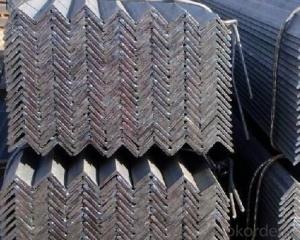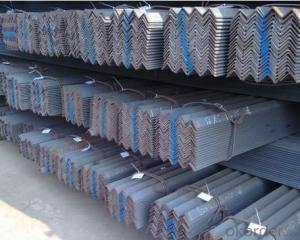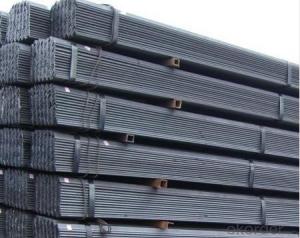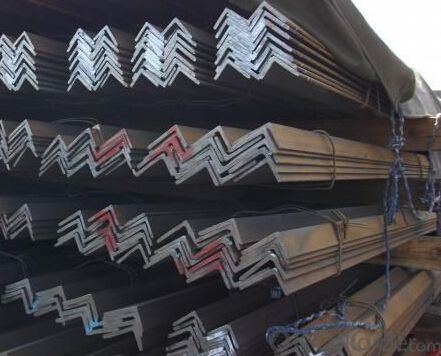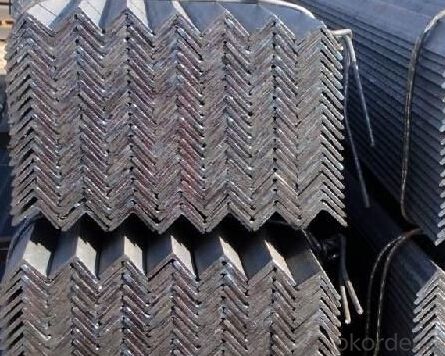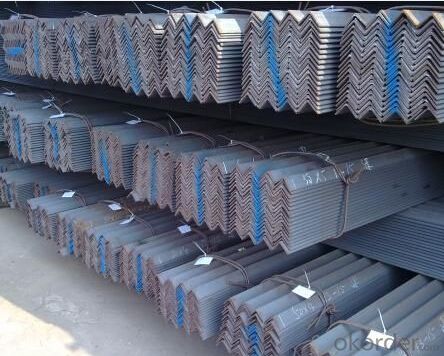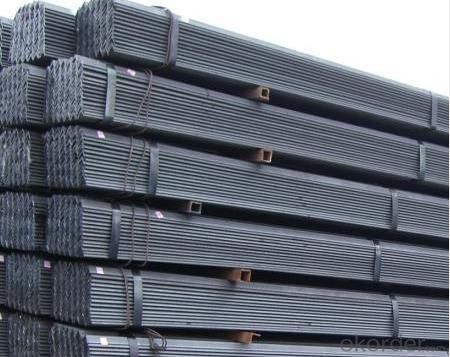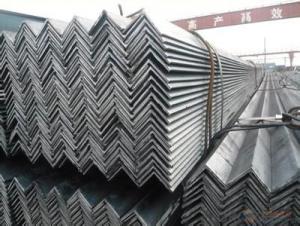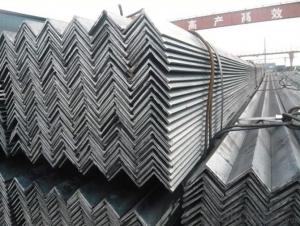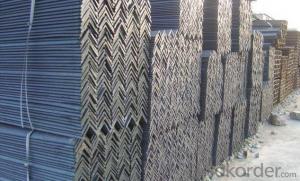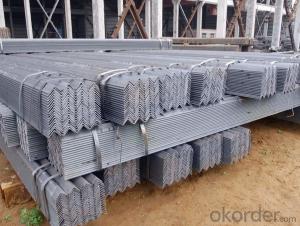Stainless Angle Steel with High Quality of GB Q235
- Loading Port:
- China Main Port
- Payment Terms:
- TT or LC
- Min Order Qty:
- -
- Supply Capability:
- -
OKorder Service Pledge
OKorder Financial Service
You Might Also Like
Product Description:
OKorder is offering Stainless Angle Steel with High Quality of GB Q235 at great prices with worldwide shipping. Our supplier is a world-class manufacturer of steel, with our products utilized the world over. OKorder annually supplies products to European, North American and Asian markets. We provide quotations within 24 hours of receiving an inquiry and guarantee competitive prices.
Product Applications:
Stainless Angle Steel with High Quality of GB Q235 are ideal for structural applications and are widely used in the construction of buildings and bridges, and the manufacturing, petrochemical, and transportation industries.
Product Advantages:
OKorder's Stainless Angle Steel with High Quality of GB Q235 are durable, strong, and resist corrosion.
Main Product Features:
· Premium quality
· Prompt delivery & seaworthy packing (30 days after receiving deposit)
· Corrosion resistance
· Can be recycled and reused
· Mill test certification
· Professional Service
· Competitive pricing
Product Specifications:
1. Standards: GB,ASTM,BS,AISI,DIN,JIS
2. Invoicing on theoretical weight or actual weight as customer request
3. Material:Material: GB Q235B, Q345B or Equivalent; ASTM A36; EN 10025, S235JR, S355JR; JIS G3192, SS400; SS540.
4. Sizes:
Sizes: 25mm-250mm | ||
a*t | ||
25*2.5-4.0 | 70*6.0-9.0 | 130*9.0-15 |
30*2.5-6.6 | 75*6.0-9.0 | 140*10-14 |
36*3.0-5.0 | 80*5.0-10 | 150*10-20 |
38*2.3-6.0 | 90*7.0-10 | 160*10-16 |
40*3.0-5.0 | 100*6.0-12 | 175*12-15 |
45*4.0-6.0 | 110*8.0-10 | 180*12-18 |
50*4.0-6.0 | 120*6.0-15 | 200*14-25 |
60*4.0-8.0 | 125*8.0-14 | 250*25 |
5. Material details:
Alloy No | Grade | Element (%) | |||||
C | Mn | S | P | Si | |||
|
|
|
|
|
|
| |
Q235 | B | 0.12—0.20 | 0.3—0.7 | ≤0.045 | ≤0.045 | ≤0.3 | |
|
|
|
|
|
|
| |
Alloy No | Grade | Yielding strength point( Mpa) | |||||
Thickness (mm) | |||||||
≤16 | >16--40 | >40--60 | >60--100 | ||||
≥ | |||||||
|
|
|
|
|
| ||
Q235 | B | 235 | 225 | 215 | 205 | ||
Alloy No | Grade | Tensile strength (Mpa) | Elongation after fracture (%) | ||||
Thickness (mm) | |||||||
| ≤16 | >16--40 | >40--60 | >60--100 | |||
≥ | |||||||
|
|
|
|
|
|
| |
Q235 | B | 375--500 | 26 | 25 | 24 | 23 | |
Usage & Applications of GB Q235 Angle Steel
Trusses;
Transmission towers;
Telecommunication towers;
Bracing for general structures;
Stiffeners in structural use.
Packaging & Delivery of GB Q235 Angle Steel
1. Transportation: the goods are delivered by truck from mill to loading port, the maximum quantity can be loaded is around 40MTs by each truck. If the order quantity cannot reach the full truck loaded, the transportation cost per ton will be little higher than full load.
2. With bundles and load in 20 feet/40 feet container, or by bulk cargo, also we could do as customer's request.
3. Marks:
Color mark: There will be color marking on both end of the bundle for the cargo delivered by bulk vessel. That makes it easily to distinguish at the destination port.
Tag mark: There will be tag mark tied up on the bundles. The information usually including supplier logo and name, product name, made in China, shipping marks and other information request by the customer.
If loading by container the marking is not needed, but we will prepare it as customer request.
FAQ:
Q1: Why buy Materials & Equipment from OKorder.com?
A1: All products offered byOKorder.com are carefully selected from China's most reliable manufacturing enterprises. Through its ISO certifications, OKorder.com adheres to the highest standards and a commitment to supply chain safety and customer satisfaction.
Q2: How do we guarantee the quality of our products?
A2: We have established an advanced quality management system which conducts strict quality tests at every step, from raw materials to the final product. At the same time, we provide extensive follow-up service assurances as required.
Q3: How soon can we receive the product after purchase?
A3: Within three days of placing an order, we will begin production. The specific shipping date is dependent upon international and government factors, but is typically 7 to 10 workdays.
Q4: What makes stainless steel stainless?
A4: Stainless steel must contain at least 10.5 % chromium. It is this element that reacts with the oxygen in the air to form a complex chrome-oxide surface layer that is invisible but strong enough to prevent further oxygen from "staining" (rusting) the surface. Higher levels of chromium and the addition of other alloying elements such as nickel and molybdenum enhance this surface layer and improve the corrosion resistance of the stainless material.
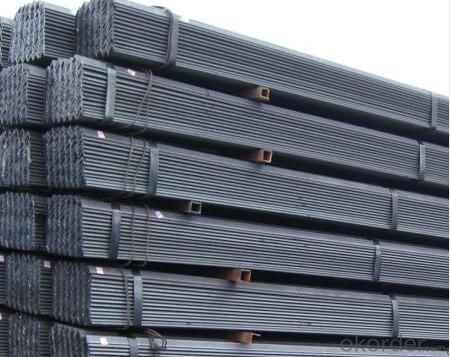
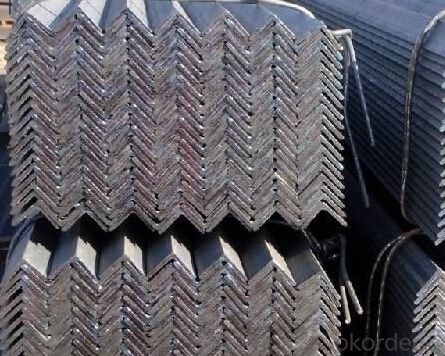
- Q: Can steel angles be used for pipe supports or hangers?
- Yes, steel angles can be used for pipe supports or hangers. Steel angles provide structural support and stability, making them suitable for holding and securing pipes in various applications.
- Q: Are steel angles resistant to pests and termites?
- Yes, steel angles are highly resistant to pests and termites. Unlike wood, which is susceptible to damage from termites and other pests, steel is an inorganic material that does not provide a food source for them. This makes steel angles a great choice for construction projects in areas prone to pest infestations. Additionally, steel is not susceptible to rot or decay, further enhancing its resistance to pests. Therefore, using steel angles in construction can help protect buildings from potential damage caused by pests and termites.
- Q: How are steel angles installed or fixed in place?
- Steel angles are commonly used in construction to provide structural support and reinforcement. They are installed or fixed in place using various methods, depending on the specific application and requirements of the project. One common method of installing steel angles is by welding. This involves permanently fusing the angles to the desired location using a welding machine. Welding provides a strong and durable connection, ensuring the angles stay in place even under heavy loads or vibrations. However, welding requires skilled labor and specialized equipment. Another method is bolting. Steel angles can be bolted to the supporting structure using bolts or screws. This method allows for easy installation and removal, making it suitable for situations where adjustments or modifications may be required. Bolting also offers flexibility in terms of repositioning or replacing the angles if needed. In some cases, steel angles are attached to the structure using adhesive bonding. This method involves applying a strong adhesive material between the angle and the supporting surface. Adhesive bonding is particularly useful when welding or bolting is not feasible or desired. However, it is important to ensure that the adhesive used is suitable for the specific application and can withstand the loads and environmental conditions. Additionally, steel angles can be installed using a combination of methods. For example, welding can be used to provide the primary attachment, while bolts or adhesive bonding can be used as secondary supports or reinforcements. It is crucial to consult with structural engineers or professionals to determine the most appropriate method for installing steel angles based on the specific project requirements, load conditions, and local building codes. Proper installation ensures the angles are securely fixed in place, providing the necessary strength and stability to the structure.
- Q: What is the maximum deflection for a steel angle beam?
- The maximum deflection for a steel angle beam depends on various factors such as the span length, load applied, and the properties of the steel angle beam itself. To determine the maximum deflection, one must consider the beam's moment of inertia, elastic modulus, and the applied load. By using appropriate formulas and calculations, engineers can determine the precise maximum deflection for a steel angle beam in a given scenario. It is important to note that the maximum deflection should always be within acceptable limits to ensure the structural integrity and safety of the beam.
- Q: What is the maximum allowable lateral torsional buckling stress for a steel angle?
- The maximum stress that a steel angle can withstand before lateral torsional buckling occurs depends on several factors, including the angle's size, shape, material properties, and the design code being followed. To determine the maximum allowable stress for a steel angle, one can consider the critical moment of inertia and its corresponding critical stress. The critical moment of inertia measures the angle's ability to resist lateral torsional buckling and is affected by its geometry and dimensions. Design codes such as the AISC Manual of Steel Construction or the Eurocode provide specific values for the maximum allowable lateral torsional buckling stress. These codes offer guidelines and formulas for calculating this stress based on the angle's dimensions, material properties, and other factors like effective length and end conditions. To accurately determine the maximum allowable lateral torsional buckling stress for a particular steel angle, it is crucial to refer to the appropriate design code or standard and seek advice from a structural engineer or consult relevant reference materials.
- Q: Can steel angles be drilled or cut?
- Yes, steel angles can be drilled or cut using appropriate tools and techniques.
- Q: Are steel angles fire-resistant?
- Yes, steel angles are fire-resistant to a certain extent. Steel is a non-combustible material, meaning it does not burn or contribute fuel to a fire. It has a high melting point, usually around 1370°C (2500°F), which allows it to maintain its structural integrity even under high temperatures. However, it is important to note that while steel itself is fire-resistant, the fire resistance of a structure or component depends on various factors such as the design, size, and configuration of the steel angles, as well as the fire protection measures implemented. Fire protection methods like fire-resistant coatings, fireproofing materials, or fire-resistant insulation can be applied to steel angles to enhance their fire resistance. These additional fire protection measures can provide a certain level of insulation, delaying the transfer of heat to the steel and extending the time it takes for the steel to reach its critical temperature. This allows occupants more time to evacuate the building and firefighters more time to control the fire. In summary, steel angles are inherently fire-resistant due to the properties of steel, but their fire resistance can be further enhanced by implementing appropriate fire protection measures.
- Q: What are the different types of steel angles used in agricultural applications?
- In agricultural applications, various types of steel angles are commonly utilized. These angles serve different purposes and possess distinct features. Here are some examples: 1. Equal Angle: This steel angle boasts equal sides and is frequently employed in agricultural structures like barns and sheds for structural reinforcement. Its stability and strength make it suitable for supporting heavy loads. 2. Unequal Angle: As the name implies, this steel angle has sides of unequal lengths. It finds widespread use in agricultural machinery, such as tractor attachments and implements. The uneven sides allow for precise positioning and attachment of various components. 3. Lipped Angle: Similar to equal angles, lipped angles have an added lip or flange on one side. This lip enhances support and rigidity, making it ideal for agricultural purposes that demand extra strength, such as fencing and gate posts. 4. Slotted Angle: Slotted angles are highly adaptable and can be adjusted to different angles as required. They are commonly employed in agricultural shelving systems, enabling farmers to create customized storage solutions for tools, equipment, and supplies. The slots present in these angles provide flexibility for modifying shelf heights. 5. Rolled Steel Angle: Rolled steel angles are created by rolling steel into angle-shaped sections. They are extensively used in agricultural construction for bracing, supporting beams, and framing. Rolled steel angles offer exceptional strength and durability, rendering them suitable for demanding agricultural environments. Each type of steel angle possesses unique characteristics and advantages. The selection of the appropriate angle depends on the specific agricultural application and the desired level of strength and support. Factors such as load-bearing capacity, durability, and resistance to corrosion should be carefully considered when choosing the suitable steel angle for agricultural use.
- Q: How do steel angles contribute to the stability of a structure?
- Steel angles contribute to the stability of a structure by providing additional strength and rigidity. They are commonly used to reinforce and support various components, such as beams and columns, by distributing the load and preventing buckling or bending. Their triangular shape allows for efficient weight distribution and helps resist lateral forces, enhancing the overall stability and structural integrity of the building.
- Q: How do steel angles perform in terms of energy efficiency?
- Steel angles are not directly associated with energy efficiency. Energy efficiency is typically evaluated based on factors such as insulation, building design, and the use of energy-efficient appliances or systems. However, steel angles can be used in construction projects to provide structural support, which indirectly contributes to the overall energy efficiency of a building by ensuring its stability and durability.
Send your message to us
Stainless Angle Steel with High Quality of GB Q235
- Loading Port:
- China Main Port
- Payment Terms:
- TT or LC
- Min Order Qty:
- -
- Supply Capability:
- -
OKorder Service Pledge
OKorder Financial Service
Similar products
Hot products
Hot Searches
Related keywords

